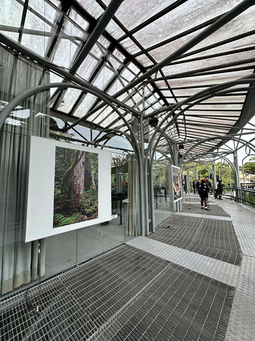
Summer Undergraduate International Research Experience
Week 1
I arrived to Curitiba, Parana on 06/09, on a Monday. This week I started working on my project, picking out the insects we would use for our tests. I put a lot of work into identifying the weapon-bearing bugs in the collections. Resources for ID are very scarce, specially for species that are not economically relevant. I changed my project slightly to be more of a comparison of morphology and biomechanical properties between insects that use their spines to fight vs those that have spines but do not use them to fight. This way, we will be able to include more species and look into something that nobody has before, which is exciting. We also had to do a lot of trouble-shooting with our camera equipment until we figured out how to efficiently use the stack-shot camera that I brought over to the university.
During the weekend, I visited many touristic spots in the city, including some parks, which are what the city is most famous for. I visited Parque Tangua and Parque Barigui, both incredibly beautiful. I also visited the famous Opera de Arame, where many concerts happen in the city.
Curitiba weather has me freezing
My mentor, Dr. Alexandre Palaoro, picked me up at the aisport around 1pm, an hour later than expecteddue to a delay. He told me a little about the city, touristic spots, andthings to do. Getting to the place I would spend the next two months in, I had a chnace to meet my roomates, three other girls that also recently moved in. I dropped my things off and we headed to Alexandre's house to pick up blankets since I was not able to bring any, and I got the chance to meet his two huge, yet adorable dogs. Any Brazilian person I told I would be visiting Curitiba warned me about the cold, and yet I failed to believe the extent of it. The week I arrived was one of the coldest weeks of the past years. And of course, I was unprepared for it. The temperature was around the 40s and 50s, and I noticed that the houses here do not have the infrastructure necessary to deal with this. Most houses and apartments do not have insulation or hot water in their taps, sometimes not even in their showers, and all have wood or tile flooring.This combined with the lack of a heater, equaled me wearing four layers of clothes almost all of the time.
That's the weather. As for the lab, Alexandre was nice enough to give me a ride so I could learn how to get into the university. I got to meet all of the undergraduates in a lab, as well as the graduate students. They were all very sweet and welcoming. We went on to setting up the stack-shot, and the ultra macro lens for taking pictures of the leg spines. Both were won through a grant, and delivered at my house back in Florida to bring over. Since we were photographing something so small, we needed to use a stack-shot, which is a machine that automatically gives you different heights of focus, and with a software, combines all pictures into one high resolution image. With the beautiful setup in place, the next step was choosing exactly what bugs I would use. We decided to use the didactic collection, which is made up of insects that students collect in classes and get surrendered to the University (I was surprised to learn that students are not allowed to keep any sort of specimens). Since we would have to essentially dismember and destroy specimens to do all the tests we wanted to, we decided that the didactic collection was the way to go. Originally, we were going to use insects of multiple genera to have an idea of the diversity of morphologies and biomechanical properties. However, upon searching the collection, we found that we did not have enough specimens of each genera to do this. I did some thinking, and I had a better idea: we could test what the differences in morphologies and biomechanics would be for insects in the Coreidae family that have spines that are weapons, versus those that have spines that are not considered weapons. This turned to be a little hard to operationalize due to the lack of information on the behavior of the insects, but we did figure out that the smaller the insects' spines and femurs, the less likely would be that they would be used to fight conspecifics.vHaving chosen 4-5 similar looking bugs under 6 genera to use in tests, came the work of identifying them and ensuring that all of the similar ones were indeed the same species. To say was a struggle would be to severely underestimate how hard it was to find key to the bugs that I had. Turns out, not a lot of people care to make dichotomous keys to Coreid bugs, and some of the few I could find were often convoluted and plainly confusing. Some bugs I thought looked interesting were not able to be identified at all. Not with keys or with the help of handy dandy iNaturalist or Google images. They could be a new species for all I know, but writing a new species description with a single specimen and no idea of locality or date of capture is way beyond my skill set as of now. At the end of the week, I had about 20 insects identified.













